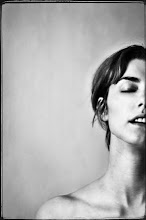I went to New York City for the purpose of having an exquisite and rejuvenating art experience. And that is exactly what I got! It was well worth the efforts to get there. I saw some of the most beautiful art from dozens and dozens of the many well known masters of art. It is such a different experience to see these things in person rather than just in an art history textbook.
I would like to highlight some of the amazing, historic photographers whose work I saw at the art museums I went to in New York City (the Guggenheim, Metropolitan and Museum of Modern Art):

Anna Atkins, (1869-1950),
Cyanotype PrintAnna Atkins was a botanist/photographer who created the first photographic book ever made, which consisted of photo-grams of plant life using a cyanotype printing process. The book is titled "Photographs of British Algea: Cyanotype Impressions." I had the opportunity to see a sample page from her original book.

Julia Margaret Cameron, (1815-1879),
Venus Chiding Cupid and Removing His Wings, Albumen PrintJulia Margaret Cameron is one of my favorite early photographers. She was very ahead of her time and a great pioneer in creating artistic photography. Her work is well worth looking into; she has some really beautiful creations.

Roger Fenton,
Rievaulx Abbey Yorkshire, 1854, Process Unknown
Roger Fenton is an early photographer who is most famous for photographing the Crimean War. He also did a lot of architectural photography. The Metropolitan Museum had a print of his on display. Unfortunately, I do not remember the exact image I saw there because it is one I wasn't familiar with it. But it was a landscape/architectural photograph, instead of one taken from the Crimean War. I like his landscape/architectural images better than his war photographs.

Anne Brigman, (1869-1950),
The Wind Harp,
Platinum Print
Gertrude Kasebier, (1852-1934),
Blessed Art Thou Among Woman, Platinum Print
Imogen Cunningham, 1925,
Magnolia Blossom,
Platinum PrintAll three of these artist are American Woman who belonged to a group called the
Photo-Secession. This was a group of photographers who fought for photography's acceptance as an art form. They approached their art with a more pictorial, soft, moody feel. I really, really enjoy this style of photography both for the philosophy behind the group and also for more dreamlike, emotional feel to the photographs.

Irving Penn,
Large Sleeve, 1951,
Gelatin Silver PrintClassic, inspirational, talented portrait photographer - known as one of the best! About 12 to 15 or so of Irving Penn's original silver gelatin prints were on display at the MOMA and they are all gorgeous prints.

Henri Cartier-Bresson,
Hyeres, France, 1932,
Silver Gelatin PrintHenri Cartier-Bresson is known as the "father to modern photojournalism." He is most famous for his photographic philosophy "the decisive moment." The best way I can think of to describe this concept is in Henri Cartier-Bresson own words: "There is nothing in this world that does not have a decisive moment...Photography is simultaneously and instantaneously the recognition of a fact and the rigorous organization of visually perceived forms that express and signify that fact." (Quote cited from
Wikipedia).
Currently at the MOMA they have an entire exhibit of Henri Cartier-Bresson's photographs. There is easily over a hundred on display. It was an incredible experience to be able to make it over there and see the exhibit.
My entire art trip to New York City was absolutely amazing and I can't wait to go back! What a wonderful thing that there can be so much beautiful art all in on city.
I have one last artist I want to highlight: William Kentridge. He was actually my favorite part about my entire trip. I liked his show the very best. He isn't even a photographer. He's actually best known for his animated films. He has done a lot with theater and film. He also does printmaking, paper-cutting, and charcoal drawings. Hope you enjoy, unfortunately these small internet images don't even do it close to enough justice...at all! His work is breathe taking in person, but this will give you an idea of his style of work:
 Drawing From Stereoscope
Drawing From Stereoscope 1998-99, Charcoal, Pastel, Color Pencil on paper

Title Unknown
 Music Box Tondo
Music Box Tondo, 2006, Archival pigment print on Hahnemuhle German etching paper
What I like about William Kentridge's work is the sense of humility that is offers. It is simple, rough, depends greatly on contour lines and has a moody edge to it. He has a large variation in his work, yet it all holds a distinct signature of his style. I can tell that thought, concept and effort were put into each piece. I relate to it on a raw human nature level, if that makes sense? Anyways, I learned a lot about my own art work and got a lot of great ideas from viewing his show. He has a gigantic exhibit going on at the MOMA right now. He filled rooms and rooms all with his own work. That really impressed me.
What are your thoughts and critic on his work, and the other artists I have shared?


















